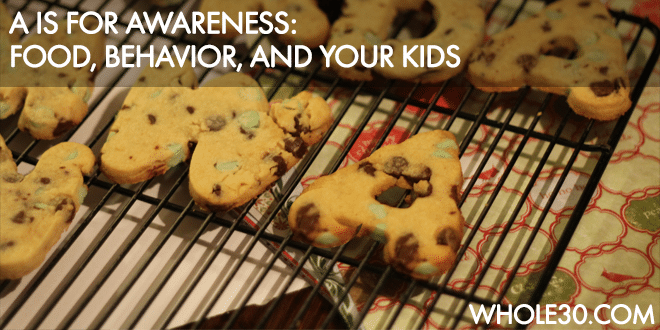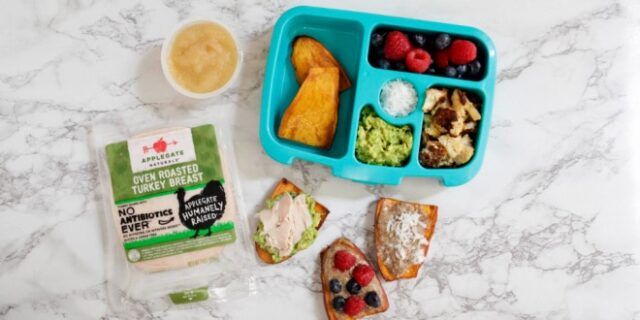As outlined in It Starts With Food, the Whole30 has two parts: elimination and reintroduction. First, you completely eliminate potentially problematic foods for a full 30 days. Then, you reintroduce those foods and observe how they affect your digestion, energy, sleep, mood, skin, medical symptoms, and general health. The idea of a scientific reintroduction of potentially problematic food groups is an easy one for adults to understand. But how do you explain those concepts to a five-year-old?
Kids Need a Different Approach
If you’re doing the Whole30 with your family, just getting your kids off the cereal, bread, yogurt, and cheese is difficult enough. But it can be even more difficult to help your kids understand the consequences of their food-related actions once their Whole30 program is over.
Younger kids can’t rationalize like adults. Chances are if you give your 10-year-old a piece of cake post-Whole30 and ask them how they feel, he’s going to give you a big, frosting-covered smile and say, “Great!” Right then and there, with all that sugar and the excitement of a treat, they sure do feel great. And when you ask them a few hours later how they feel, they may not want to admit (or be able to identify) that the cake gave them a belly-ache, or made their head hurt, or make them cranky.
So how do you, as a parent, help your kids connect their food choices with the health consequences? The biggest tool you’ve got in this particular Whole30 arsenal is awareness. Ask your kids pointed questions that force them connect the food choices they made with the physical, mental, and behavioral effects that food is having. The best part? This tool works at any age, as long as your child is able to understand the basic principles of cause and effect (or in this case, action and consequences).
Your Awareness Checklist

The key is to be prepared ahead of time, before the “less healthy” food choice makes its way into your child’s hands. The first step in the “A is for Awareness” plan is to use your parental intuition, based on your observations of their behavior, state of mind, and physical status during their Whole30 program. We bet you’ve already got a good idea of how certain foods will affect your child based on what you didn’t observe during their Whole30, but here are some questions for you to consider.
- Did your child’s daily 3 PM tantrum miraculously disappear?
- Did their ability to pay attention during homework dramatically improve?
- Did their teachers or playmates’ parents express an observed improvement in behavior?
- Did they no longer experience stomach troubles after every meal?
- Were they no longer quite so fussy at mealtime?
- Did their eczema, acne, or skin rash clear up?
- Were you able to discontinue their asthma inhaler or allergy medicine?
These are just some examples our Whole30 parents have reported back to us at the completion of their family’s program, but you may have noticed different results with your children.
The Reintroduction Period

Now that you know what to look for, it’s time to start reintroducing food groups one at a time, carefully and systematically, to evaluate how they might be affecting your child. Do this when you have full control over the foods they reintroduce, and can be present for at least the next few hours to evaluate the results. Choose your food group for that particular day, reintroduce, then refer back to the lst you created in Step 1 and observe.
Watch your child for any signs or symptoms related to the reintroduction of that particular food group, physically, mentally, and especially behaviorally. (Gluten, sugar, and artificial sweeteners in particular tend to manifest in kids as temper tantrums, crankiness, attention deficits, or other undesirable behaviors.
Introducing Awareness

Now it’s time to bring the connection of the food and the results to your child’s attention. If the effects are physical (stomach ache, digestive upset, asthma, skin rash, etc.) you can address the condition immediately, while it’s happening. If the foods bring about some unpleasant behaviors, you may want to wait until the moment has passed before addressing it calmly with your child. Don’t wait too long, however. Your children are most likely to link their actions with the resulting consequences when it’s pointed out to them in real-time, as opposed to several hours or a day later.
Your opening line should connect the dots of their poor food choices and the consequences you’ve since observed. Be precise in your language, and try to point out things that are factual, not things you are interpreting based on their behavior. (You may think you son was short-tempered with his sister after eating the cookie, but that point could be argued. The fact that you had to put him in time-out after he refused to share, however, is a fact.) After you’ve pointed out the actions and consequences, be sure to wrap it up with the conclusion you’re trying to emphasize: that making the poor food choice had a negative effect on your child.
Examples of action/consequence/summary statements are as follows:
- “Remember how yesterday, you ate berries with coconut milk for dessert, and played so nicely with your sister all night? And today, you ate two chocolate chip cookies for dessert and ended up fighting with her and getting punished? I think the cookies made you cranky.”
- “You haven’t had to use your inhaler in two weeks. Today, you had some milk and you had to use your inhaler for the first time. I think eating dairy makes your asthma flare up.”
- “Last week after that yummy dinner of meatballs and zoodles, you did your homework super fast and had extra time to play. Tonight after you ate meatballs with spaghetti, you couldn’t concentrate and didn’t have any play time left. I think there’s something in the spaghetti that makes it hard for you to focus.”
- “Your belly has been feeling so good the last few days! But today, as soon as you ate that toast, your tummy got all big and made funny noises. I think your belly is telling us it doesn’t want bread anymore!”
Create a New Plan

Once you’ve established some awareness within your child, it’s time to get their buy-in–because without their support, things won’t effectively change. This needs to be a partnership, not a top-down order! They may not be ready to admit that their former favorite food is the one causing all the problems, but the point here is just to get them to agree that the consequences you noticed aren’t awesome, and wouldn’t it be great if things could be different? Just get them saying “yes” a few times and a row and you’re golden. Here are some examples of buy-in conversations.
- “What if you could spend less time in time-outs? Would you want to do that?”
- “Wouldn’t it be nice to play soccer at school or run down the street with your friends without worrying about where your inhaler is all the time?”
- “Wouldn’t it be nice to get all your homework done faster so you had more time to play?”
- “Wasn’t it nice when your belly didn’t hurt all the time? Don’t you wish you could have a happy belly every day?”
Keep trying different angles until something you say actually resonates with your child. If they’re really stubborn or totally in denial, the best you might be able to do is a grudging, “Yeah, I guess that could be it, maybe…” Don’t beat yourself up if that’s as far as you get. It’s a start–a platform you can build on with future experiences.
Once you’ve got some semblance of buy-in (grudging or not), then it’s time to come up with a plan together. Put yourself in their corner, on their side. Ask them to help you come up with a solution that’s best for their health, on their own terms. Offer them options, always starting with the one you know is best for their health, and help them see the trade-off; what they’re getting for the things they’re giving up.
In the case of kids, you might need to come up with some “less bad” scenarios if you’re trying to transition them out of their old, comfortable way of eating. While we don’t encourage adults to simply replace junk foods, desserts, or treats with versions made with “Paleo” ingredients, sometimes kids need a little incentive to make those changes.
Here are some examples of strategy conversations.
- “If cookies make you cranky, and you really like fruit and coconut milk, why don’t we just make that your dessert from now on? I bet you’ll go a whole week without a single time-out if we do that! And if you really miss the chocolate chips, we can add some cocoa nibs to your dessert once in a while. Cocoa won’t make you cranky like those yucky cookies.”
- “I know everyone eats ice cream after the soccer games. What if we made our own dairy-free ice cream at home? I have a recipe for chocolate-chip coconut milk ice cream we could try tonight!”
- “Let’s go back to the no spaghetti or cereal rule for a week and see if that helps you concentrate. I bet it does – and I bet that means you’ll have more time to play, too. Who cares about boring old spaghetti if you’ve got more time to play outside!”
- “Let’s try eating fruit instead of toast for breakfast. Fruit never made your belly hurt, did it? And did you know we can make fun sandwiches out of big lettuce leaves or crispy sushi wraps, too? That’ll be fun.”
Good Food Mission Accomplished
So there you have it–how to use awareness to (eventually) help your child change their behaviors, and embrace this healthy, happy, sustainable way of eating as they grow and mature. While your child’s behavior may not change overnight, these are the kinds of conversations that help them take their health into their own hands as they get older, and make good food choices on their own as they stray further and further from the nest.
Has an awareness approach worked for your child? Do you have your own strategies for helping kids eat better? Share them with our readers in comments.
















